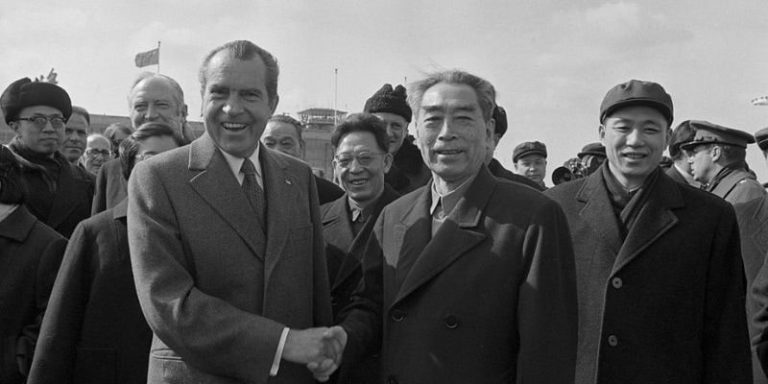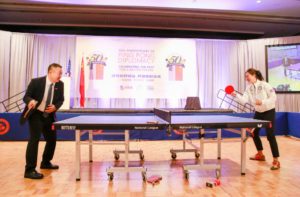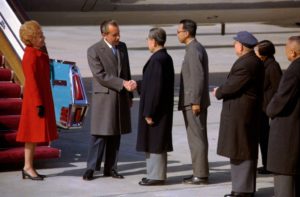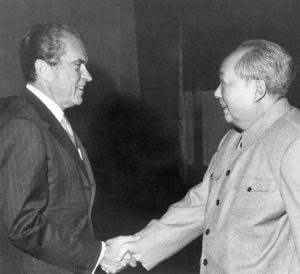50 Years Since Nixon Went to China: Ping-Pong Diplomacy
Half a century ago, President Nixon aimed to open diplomatic ties with China.
By: GenZ Staff | February 22, 2022 | 741 Words

Zhou Enlai And Richard Nixon shake hands (Getty Images)
Liberty Nation GenZ is running a special edition on the 50th anniversary of President Richard Nixon’s visit to China. In Part One, we examine the lead-up to the event and why it was so momentous.
China is emerging as one of the big global superpowers, and it seems determined to expand its power and territory. While today the U.S. and China are seen as rivals on the world stage, that wasn’t always the case.
On February 21, 1972, Richard Nixon became the first U.S. president to travel to China. February 2022 marks the 50th anniversary of Nixon’s visit. It was an important event, as it opened a conversation between the two countries.
When Nixon became president in 1969, China was a closed country. It was two decades after the Communist Revolution, when leader Mao Zedong announced the creation of the People’s Republic of China (PRC). The U.S. has never supported communist systems, and so it backed the other side in the revolution – the Nationalists – but lost. With the Communists declaring victory in China, it was not long before ties between the two countries collapsed. For 20 years there was little contact.
It wasn’t until a surprise announcement by Nixon on July 15, 1971, that Americans knew of a plan to rebuild links. The president announced he had accepted an invitation to visit Beijing, China’s capital city. He said: “I have taken this action because of my profound conviction that all nations will gain from a reduction of tensions and a better relationship between the United States and the People’s Republic of China.”
Making the Meeting Possible

Liu Guoliang of the Chinese Table Tennis Association and Virginia Sung of USA Table Tennis play a match celebrating the 50th anniversary of Ping-Pong Diplomacy in 2021 (Photo by Liu Guanguan/China News Service via Getty Images)
It turned out Nixon had been holding covert talks with the PRC for months, and National Security Adviser Henry Kissinger had even traveled to China in secret. While on a trip to Pakistan, Kissinger faked a stomachache and took a secret flight to China while he was supposedly resting in a hotel room.
Amazingly, a ping-pong tournament also made Nixon’s visit possible. During the 1971 World Table Tennis Championships in Japan, U.S. player Glenn Cowan was seen socializing with Chinese competitor Zhuang Zedong. Soon after, the American team was invited to visit China even though few foreigners were allowed to enter the country at that time. In April, the U.S. players went to Beijing and spent the weeklong trip playing ping-pong and sightseeing. A few months later, in July, the Chinese team visited California.
Sports, especially table tennis, were important in the PRC, and athletes were some of the only Chinese citizens allowed to travel overseas. The episode became known as “ping-pong diplomacy” because it gave a pathway for the two nations to get together.

(Photo by Bryan Schumaker/PhotoQuest/Getty Images)
The Visit
When Nixon and his wife, Patti, flew to Beijing, they walked down the stairs of Air Force One to be greeted by Chinese Premier Zhou Enlai. Patti wore a red coat – the color of both communism and traditional Chinese culture.
Nixon then met with Chairman Mao Zedong, China’s communist leader. Although the elderly Mao was getting sick by that stage, the two men had a short meeting and were photographed joking together.
Nixon presented a statue of two swans, called The Bird of Peace, as a gift to Mao. It is now in the National Museum of China.

President Nixon shaking hands with Mao Zedong (Getty Images)
Photos were taken of Nixon shaking hands with both Zhou Enlai and Mao Zedong. These images starkly contrasted with another incident. In 1954, Secretary of State John Foster Dulles had refused to shake the hand of Zhou Enlai during a rare meeting.
“The U.S. had literally turned a cold shoulder to [Zhou] in 1954,” said author Evan Thomas, according to History.com. “For Nixon to hold out his hand was a clear signal that times had changed and that America was ready to embrace the Chinese. It was brilliant stagecraft.”
You can read Part Two of this special edition on the anniversary of Nixon’s visit to China here.
















